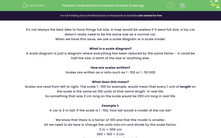It's not always the best idea to have things full size. A map would be useless if it were full size; a toy car doesn't really need to be the same size as a normal car.
When we have this issue, we use a scale diagram or a scale model.
What is a scale diagram?
A scale diagram is just a diagram where everything has been reduced by the same factor - it could be half the size, a tenth of the size or anything else.
How are scales written?
Scales are written as a ratio such as 1 : 100 or 1 : 50 000
What does this mean?
Scales are read from left to right. The scale 1 : 100 for example, would mean that every 1 unit of length on the scale is the same as 100 units of that same length in real life.
So something that was 2 cm long on the scale would be 200 cm long in real life.
Example 1:
A car is 3 m tall. If the scale is 1 : 100, how tall would a model of the car be?
We know that there is a factor of 100 and that the model is smaller.
All we need to do here is change the units into cm and divide by the scale factor.
3 m = 300 cm
300 ÷ 100 = 3 cm
The model car would be 3 cm tall.
Example 2:
A model is made of a 2 m tall man. If the model is 4 cm tall, what is the scale?
The first thing we should notice here is that the units are different, so we need to make them the same.
2 m = 200 cm
Step 2 is to write these numbers as a ratio (remember the model comes first))
4 : 200
Out third and final step is to simplify this ratio. In this example, we can divide both numbers by 4 to give
1 : 50
Now let's have a go at some questions on this.








